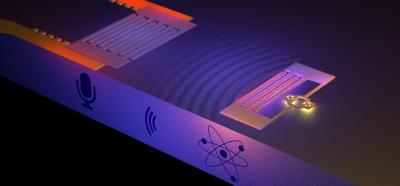The interaction between atoms and light has been studied extensively but making acoustic waves couple to an artificial atom is a newer endeavor. An artificial atom is an example of such a quantum electrical circuit. Just like a regular atom, it can be charged up with energy which it subsequently emits in the form of a particle. This is usually a particle of light, but the atom in the Chalmers experiment is instead designed to both emit and absorb energy in the form of sound.
"According to the theory, the sound from the atom is divided into quantum particles," says Martin Gustafsson, the Science paper's first author. "Such a particle is the weakest sound that can be detected."

On the right, an artificial atom generates sound waves consisting of ripples on the surface of a solid. The sound, known as a surface acoustic wave (SAW) is picked up on the left by a "microphone" composed of interlaced metal fingers. According to theory, the sound consists of a stream of quantum particles, the weakest whisper physically possible. The illustration is not to scale. Credit: Philip Krantz, Krantz NanoArt
Since sound moves much slower than light, the acoustic atom opens entire new possibilities for taking control over quantum phenomena. "Due to the slow speed of sound, we will have time to control the quantum particles while they travel. This is difficult to achieve with light, which moves 100,000 times more quickly."
The low speed of sound also implies that it has a short wavelength compared to light. An atom that interacts with light waves is always much smaller than the wavelength. However, compared to the wavelength of sound, the atom can be much larger, which means that its properties can be better controlled. For example, one can design the atom to couple only to certain acoustic frequencies or make the interaction with the sound extremely strong. The frequency used in the experiment is 4.8 gigahertz, close to the microwave frequencies common in modern wireless networks. In musical terms, this corresponds approximately to a D28, about 20 octaves above the highest note on a grand piano.
At such high frequencies, the wavelength of the sound becomes short enough that it can be guided along the surface of a microchip. On the same chip, the researchers have placed an artificial atom, which is 0.01 millimeters long and made of a superconducting material.
The sample that the researchers use is made on a substrate of gallium arsenide (GaAs) and contains two important parts. The first one is the superconducting circuit that constitutes the artificial atom. Circuits of this kind can also be used as qubits, the building blocks of a quantum computer. The other essential component is known as an interdigital transducer (IDT). The IDT converts electrical microwaves to sound and vice versa. The sound used in the experiment has the form of surface acoustic waves (SAWs) which appear as ripples on the surface of a solid. The experiments are performed at very low temperatures, near absolute zero (20 millikelvin), so that energy in the form of heat does not disturb the atom.
The theoretical research group, led by Göran Johansson, recently published a paper on how the acoustic atom functions: http://link.aps.org/doi/10.1103/PhysRevA.90.013837
Source: Chalmers University of Technology




Comments